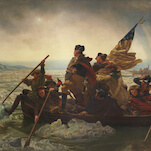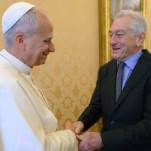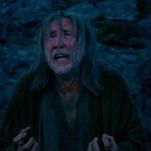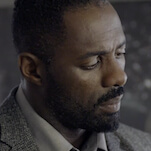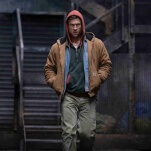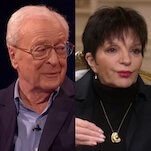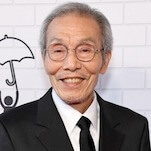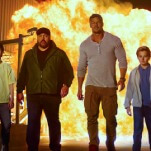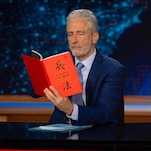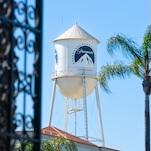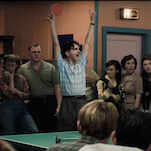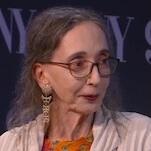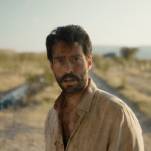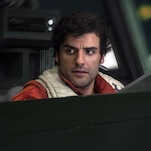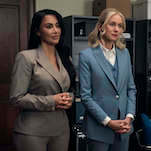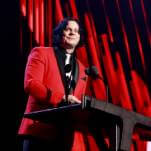Paul Thomas Anderson rockets Thomas Pynchon into the present
One Battle After Another smooths the author's sensibilities into a big-budget Hollywood tentpole.
Photo: Warner Bros.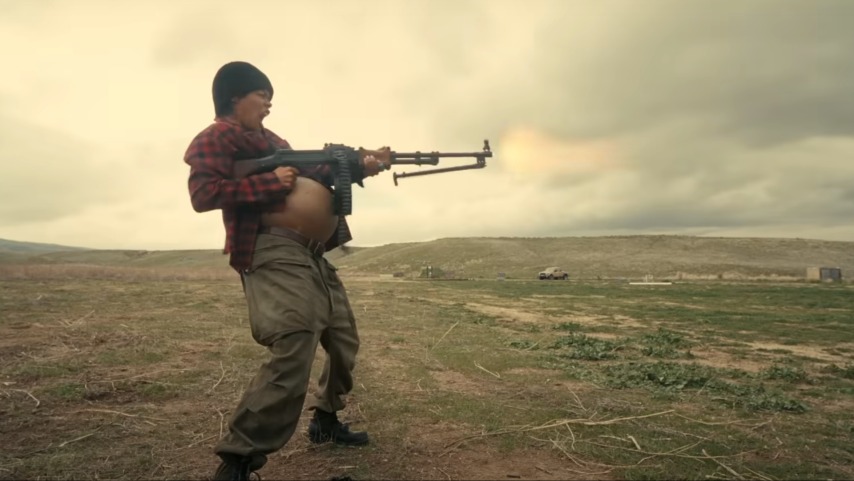
It was not until after his wunderkind years wrapped up with Magnolia that Paul Thomas Anderson started sincerely working with adapted material. Never one for a traditional approach, his first “adapted” film, Punch-Drunk Love, was an extrapolation on a news story about a man who manipulated an airline points promotion by buying pudding cups to get flights for pennies on the dollar. Next he tackled Upton Sinclair’s novel Oil!, or at least the first 150 of the book’s 500-plus pages. Oil! merely served as a foundation for his historic epic There Will Be Blood. Inherent Vice was a different story, closely following Thomas Pynchon’s 2009 novel of the same name to become Anderson’s most faithful adaptation. Though inspired by another Pynchon novel—this time, 1990’s Vineland—One Battle After Another is much closer to Anderson’s other works, using the book as an adaptive jumping-off point to create his own story about found families. One Battle After Another is an application of Pynchon rather than just an adaptation, with Anderson building on the author’s sensibilities and filtering it through the lens of a big-budget, tentpole Hollywood film.
It is easy to see what Anderson took as a foundation and reworked in his own words: The novel’s protagonists, ex-hippie freak Zoyd Wheeler and his daughter Prairie get turned into Leonardo DiCaprio and Chase Infiniti’s characters Bob and Willa Ferguson, with the runaway double agent (lost love to the former and mother to the latter) Frenesi getting turned into the revolutionary-to-rat Perfidia Beverly Hills. The old federal agent foe returning from the past? Brock Vond becomes the hilariously uptight and impotent Col. Steven J. Lockjaw, played in a career-best performance by Sean Penn. But beyond that, Anderson’s Batkin Cross isn’t Pynchon’s Vineland. There is no breakaway hippie state called the People’s Republic Of Rock And Roll, nor are there any ninjettes—although Benicio del Toro’s character, Sensei Sergio, does run a dojo that Willa attends. Moreover, while Pynchon’s novel explored 1984 by way of the fallout of ’60s radicalism, Anderson’s film takes place squarely in the present.
This is similar to how Oil! became There Will Be Blood, where Anderson took the basic concept from Sinclair’s novel and switched the protagonists (the book follows an oilman’s son while Anderson’s film is about the father). In a 2008 A.V. Club interview, Anderson explained that he only used the first third of the novel because “there is a certain point where [Sinclair] strays really far from what the original story is.” This is Anderson rejecting Sinclair’s focus, that being writing a socialist polemic set within a specific frame of American history (in the case of Oil!, the corruption in the Teapot Dome scandal). Anderson was not interested in this, nor was he interested in adapting any of Sinclair’s particularly left-wing story beats, like the workers on the oil field organizing a strike after a fatal blowout.
Dad and Bunny from Oil! are not Daniel and H.W. Plainview, and Anderson’s opening of There Will Be Blood, including the adoptive origin of Daniel’s son, is his own. The book’s central examination—capitalist corruption and the inspiring undercurrent of labor fighting for its rights—is not Andersonian. Sinclair’s oilman is indicative of America’s class conflict, while the selfish Plainview is an anti-social perversion against familial bonds. Anderson’s Great Man story takes place in a world of barren landscapes dotted by the occasional homestead, derrick, or evangelist congregation—it is more a psychological space than a real California.
The same could be said of Anderson’s follow-up, The Master. For a film inspired by L. Ron Hubbard and the early days of Scientology, it is odd that Anderson seems more intent on weaving a narrative of opposing forces—of masculine id and superego. Even more so than There Will Be Blood, The Master is a film of close-ups, where the world is specific but serves first as a place to frame the characters within. But the key to Anderson’s approach in adapting projects lies in how he handled Inherent Vice. Anderson’s film stays true to the details and beats of the book’s 1970 Los Angeles, following “Doc” Sportello (Joaquin Phoenix) as he fumbles, stoned, through a grand conspiracy involving his ex-old lady, the disappearance of a big real estate developer, and the emergence of a shadowy syndicate called the Golden Fang. Anderson’s sensibilities successfully slip into Pynchon’s paranoid ’70s, playing in that transitional moment similarly to how Boogie Nights looked at the cultural fulcrum of the ’80s. But, crucially, history is something that just happens to people in Paul Thomas Anderson’s films. They’re drops in an ocean whose tide is inevitable.
In Pynchon’s work, history is a work of hidden construction, where secret machinations drive society. In Pynchon, one finds corporate drug-smuggling operations or government agents hiding within counterculture movements. Anderson, while more than willing to use these as a backdrop, is more expressly interested in people. His Inherent Vice has all the flavor and texture of Pynchon’s novel, but Anderson’s locked-in viewpoint from Doc services a story more specifically interested in friendship, lost love, and the way people affect each other’s lives. These hold its attention far more than peering through the opacity of the conspiracy at hand. Anderson is doing that intentionally; he’s spoken repeatedly about his desire to make Inherent Vice a work not easily followable in real time so that the audience focuses elsewhere, like on performance and character work. The closest Anderson ever gets to making his own conspiracy film is Magnolia—a conspiracy of people, where his directorial hand entangles their disparate lives.
